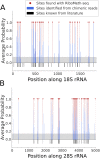High-throughput identification of C/D box snoRNA targets with CLIP and RiboMeth-seq
- PMID: 28031372
- PMCID: PMC5389715
- DOI: 10.1093/nar/gkw1321
High-throughput identification of C/D box snoRNA targets with CLIP and RiboMeth-seq
Abstract
High-throughput sequencing has greatly facilitated the discovery of long and short non-coding RNAs (ncRNAs), which frequently guide ribonucleoprotein complexes to RNA targets, to modulate their metabolism and expression. However, for many ncRNAs, the targets remain to be discovered. In this study, we developed computational methods to map C/D box snoRNA target sites using data from core small nucleolar ribonucleoprotein crosslinking and immunoprecipitation and from transcriptome-wide mapping of 2΄-O-ribose methylation sites. We thereby assigned the snoRNA guide to a known methylation site in the 18S rRNA, we uncovered a novel partially methylated site in the 28S ribosomal RNA, and we captured a site in the 28S rRNA in interaction with multiple snoRNAs. Although we also captured mRNAs in interaction with snoRNAs, we did not detect 2΄-O-methylation of these targets. Our study provides an integrated approach to the comprehensive characterization of 2΄-O-methylation targets of snoRNAs in species beyond those in which these interactions have been traditionally studied and contributes to the rapidly developing field of 'epitranscriptomics'.
© The Author(s) 2016. Published by Oxford University Press on behalf of Nucleic Acids Research.
Figures







Similar articles
-
High-throughput single-base resolution mapping of RNA 2΄-O-methylated residues.Nucleic Acids Res. 2017 Feb 17;45(3):1433-1441. doi: 10.1093/nar/gkw810. Nucleic Acids Res. 2017. PMID: 28180324 Free PMC article.
-
Characterisation of the U83 and U84 small nucleolar RNAs: two novel 2'-O-ribose methylation guide RNAs that lack complementarities to ribosomal RNAs.Nucleic Acids Res. 2000 Mar 15;28(6):1348-54. doi: 10.1093/nar/28.6.1348. Nucleic Acids Res. 2000. PMID: 10684929 Free PMC article.
-
Sequence and structural elements of methylation guide snoRNAs essential for site-specific ribose methylation of pre-rRNA.EMBO J. 1998 Feb 2;17(3):797-807. doi: 10.1093/emboj/17.3.797. EMBO J. 1998. PMID: 9451004 Free PMC article.
-
The expanding snoRNA world.Biochimie. 2002 Aug;84(8):775-90. doi: 10.1016/s0300-9084(02)01402-5. Biochimie. 2002. PMID: 12457565 Review.
-
[Small nucleolar RNAs].Mol Biol (Mosk). 2007 Mar-Apr;41(2):246-59. Mol Biol (Mosk). 2007. PMID: 17514894 Review. Russian.
Cited by
-
snoDB: an interactive database of human snoRNA sequences, abundance and interactions.Nucleic Acids Res. 2020 Jan 8;48(D1):D220-D225. doi: 10.1093/nar/gkz884. Nucleic Acids Res. 2020. PMID: 31598696 Free PMC article.
-
Eukaryotic Box C/D methylation machinery has two non-symmetric protein assembly sites.Sci Rep. 2021 Sep 2;11(1):17561. doi: 10.1038/s41598-021-97030-y. Sci Rep. 2021. PMID: 34475498 Free PMC article.
-
Detection and Analysis of RNA Ribose 2'-O-Methylations: Challenges and Solutions.Genes (Basel). 2018 Dec 18;9(12):642. doi: 10.3390/genes9120642. Genes (Basel). 2018. PMID: 30567409 Free PMC article. Review.
-
Emerging Classes of Small Non-Coding RNAs With Potential Implications in Diabetes and Associated Metabolic Disorders.Front Endocrinol (Lausanne). 2021 May 10;12:670719. doi: 10.3389/fendo.2021.670719. eCollection 2021. Front Endocrinol (Lausanne). 2021. PMID: 34040585 Free PMC article. Review.
-
The Epitranscriptome in Translation Regulation.Cold Spring Harb Perspect Biol. 2019 Aug 1;11(8):a032623. doi: 10.1101/cshperspect.a032623. Cold Spring Harb Perspect Biol. 2019. PMID: 30037968 Free PMC article. Review.
References
-
- Li S., Mason C.E.. The pivotal regulatory landscape of RNA modifications. Annu. Rev. Genomics Hum. Genet. 2014; 15:127–150. - PubMed
-
- Birkedal U., Christensen-Dalsgaard M., Krogh N., Sabarinathan R., Gorodkin J., Nielsen H.. Profiling of ribose methylations in RNA by high-throughput sequencing. Angew. Chem. Int. Ed. Engl. 2014; 10.1002/anie.201408362. - PubMed
-
- Dominissini D., Moshitch-Moshkovitz S., Schwartz S., Salmon-Divon M., Ungar L., Osenberg S., Cesarkas K., Jacob-Hirsch J., Amariglio N., Kupiec M. et al. . Topology of the human and mouse m6A RNA methylomes revealed by m6A-seq. Nature. 2012; 485:201–206. - PubMed
-
- Schaefer M. RNA 5-methylcytosine analysis by bisulfite sequencing. Methods Enzymol. 2015; 560:297–329. - PubMed
Publication types
MeSH terms
Substances
LinkOut - more resources
Full Text Sources
Other Literature Sources
Molecular Biology Databases

